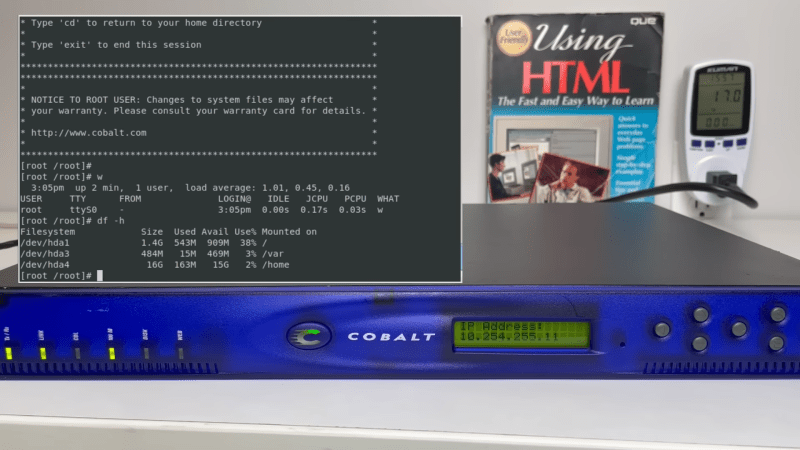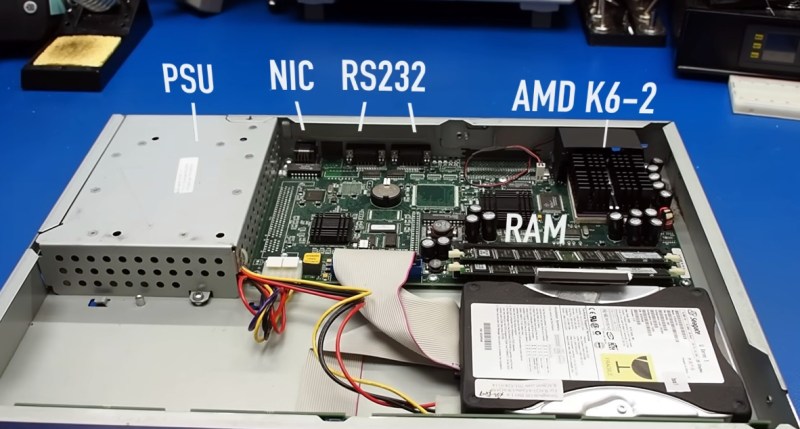Hackaday readers fit into two broad categories: those who experienced the wild and woolly early days of the Internet, and those who are jealous that they missed it. And it’s safe to say that both groups will get something out of this aggressively Web 1.0 retro experience, courtesy of a server that was actually part of it.
This comes to us via The Serial Port, a virtual museum dedicated to 90s technology, where curators [Mark] and [Ben] managed to find a pair of Cobalt RaQ 3 servers from the late 1990s. The RaQ was the first true “Internet appliance,” designed to be as simple as possible to set up and operate. If you wanted to get your small business online, machines like these were just the ticket. They were designed to be as plug-and-play as possible, and they did a pretty good job of it, at least for the time.
The machines that showed up were quite the worse for the wear, which is understandable given the decades since they were last relevant, but that just makes it all the more fun to get them going again. One didn’t even come close to booting, but the other showed more promise.
The video below is the first of a three-part series, and has a nice introduction to the RaQ and its important place in the early Internet, as well as a peek inside the two machines. That revealed some leaky caps that needed replacement in Part 2; after that minor surgery and a little persuasion, the 300-MHz screamer was ready for a test run. It worked, and The Serial Port put it right to work in Part 3 hosting a gloriously retro home page. Hit the link at the top of the article and enjoy the 90s all over again — the visitor counter, the mixed fonts, the “Under Construction” animated GIF, and the reminder to bookmark this page in your browser, which was probably Netscape Navigator. We love the guestbook, too. But — no marquee?
Nice job, [Mark] and [Ben], and kudos for keeping this little slice of computing history alive.

















how i miss the blink tag… and of course border=10
I just say my html 3.0 for dummies book. Blink tag is the best. Who remembers frames?
You want frames? I’ll give you frames! https://www.zark.com/headscape/frames.html
I still have my hacked i-opener. I had no idea about it at the time so I hacked one well after its prime. It would _just_ play an mp3 with WinAMP. Move the mouse and it would stutter. Still it’s an entire P166ish computer in a screen. I haven’t powered it up in a long time, but it still sits here as a retro trophy in the office. :)
What broken computer do you use? My 486 can play MP3s via WinPlay3 on Win3.1x. 😁
Likewise, my 486 (an AMD 5×86 at 133MHz) could run Windows 95 and Winamp 2 very comfortably. The only time it struggled was when I ran a visual equaliser at 1600×1200 resolution(!) The abysmal fps ( roughly 0.2) was great for grabbing screenshots to make abstract wallpapers, though.
Is an AMD 586 a 486 I was under the impression that it was a pentium compatible chip, that ran over twice as fast a 486.
Just kidding, the computer is probably fine. It’s maybe an IRQ conflict or because Windows can’t do proper multitasking. 🙂
If you like, try OS/2 Warp 4 and WarpAmp on that PC.
https://www.os2world.com/wiki/index.php/WarpAmp
Alternatively, BeOS/Zeta/Haiku are worth a try.
At least their retro webpage mostly works with javascript disabled, a lot of sites these days will not even load.
Hm.They look more futuristic too me than what we use nowadays.
With the exception of that K6 and the rubber coated HDD, of course. And the lack of optical ethernet ports. No wait, they’re still not conmon yet, we still use lame RJ45 ports. ;)
Starting udev!
I nearly got a Cobalt Qube back then. Still doesn’t seem that long ago!
I had a Qube until fairly recently, when I donated it to the Media Archaeology Library at University of Colorado, Boulder. It was an early Amazon server, and a friend adopted it when they decommissioned it. When I got it, it was sloooowwwww and very out of date but there were some very decent MIPS ports for netBSD for it, and that made it a lot more secure. It wasn’t particularly moddable, as it only had one PCI port, no provision for keyboard or screen, of course, but it did work well as a tiny server.
I had a Cobalt RaQ 2, bought new with my reseller discount. They were great little basic servers for the time. I ran it until 2008 as my email, DNS, and basic web server. 250 MHz MIPS processor, 10GB IDE drive, and I believe 256 MB of RAM.
Still have a RaQ2 and a Qube. They were supported by OpenWrt for a while, but support was dropped in 2012.
My wife used to work in tech support for these.
my first server that lived in my childhood bedroom!
I have a stack of Raq3s collecting dust. Long after they were out of service but still years ago I found details online for getting a then-modern kernel (2.6 maybe?) on them. I never got around to it though. I’m not too hopeful that the same directions would allow a now-modern kernel to run on there but I don’t know.
So… is there a large nostalgia crowd that wants these things? Or should they just be recycled? Or maybe turned into rack mount Pi cases. In which case I still don’t need this many…
I would hate to destroy something that people are still coveting for the retro nostalgia but I don’t want them in my garage forever either.
There does seem to be interest in people bringing these back online for nostalgia / retrocomputing. You could probably sell them on eBay to get them in a new home and to sort of justify your time in shipping them.
http://w10.host/ – hosting for WEB 1.0 web pages
http://old.net.eu.org/ – CMS for WEB 1.0
https://github.com/turboblack/HamsterCMS also that CMS – fresh releases and themes